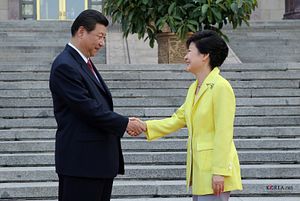Three years after negotiations began, China and South Korea have officially signed a free trade agreement. Chinese Commerce Minister Gao Hucheng and South Korean Trade Minister Yoon Sang-jick inked the document on Monday in Seoul, with President Xi Jinping and Park Geun-hye sending along letters expressing their support for and commitment to the deal.
The agreement was finalized over six months ago, in November 2014. On the sidelines of the APEC meeting in Beijing,Xi and Park announced that negotiations had been completed on a deal expected to eventually eliminate tariffs on 90 percent of the goods traded between China and South Korea. Now that it’s been officially signed, the FTA is expected to enter into force later this year, once both legislatures have approved it.
In her letter to Xi, Park called the deal a “historic milestone in the countries’ efforts to deepen their strategic cooperative partnership,” according to Yonhap News. Similarly, Xi hailed the FTA as a “monumental event” that will “not only lead to a new leap in trade relations between the two countries but also bring practical benefits to the people of both countries.”
Seoul’s trade ministry estimates the the deal will boost China-South Korea trade to over $300 billion a year, up from $215 billion in 2012, when the negotiations began. It’s also projected to lift South Korea’s GDP by roughly 1 percent over the next ten years. China, meanwhile, is expected to see its GDP rise by 0.3 percent during the same time frame thanks to the FTA. And we could see more benefits in the future, as the two sides are expected to begin negotiation over removing barriers to the service sector in 2017.
Though both China and South Korea have other FTAs in the books, this deal is uniquely significant. China is already South Korea’s largest trading partner, and Seoul expects this deal to produce unique dividends on par with the size of the overall trade relationship. The FTA with South Korea is also China’s largest such deal in terms of the trade volume affected.
Meanwhile, Chinese researchers argue that the new FTA with South Korea “represents a higher level of trade liberalization and market opening-up” than any other FTAs China has negotiated. An unnamed South Korean official seemed to agree, telling Yonhap that the FTA with South Korea shows China “has accepted and opened its market to international norms.”
The deal has even wider significance if viewed as a stepping stone. China also wants to finalize a trilateral FTA linking itself, South Korea, and Japan; the China-South Korea FTA is a useful building block in that effort. More ambitiously, Beijing hopes to finish negotiations this year on the Regional Comprehensive Economic Partnership (RCEP), a trade agreement linking the 10 ASEAN member countries with China, South Korea, Japan, India, Australia, and New Zealand. RCEP is often read in direct opposition to the United States’ push for the Trans-Pacific Partnership.

































